Are you considering investing in an interactive touchscreen experience for your advanced manufacturing business?
If you’re looking to showcase complex products and solutions in a visual, immersive way at an event, tradeshow or in a customer-facing area of your business then a touchscreen is a great way to bring your message to life. However, if like many of the clients who first approach us, having never ventured into this territory before, you may have a few questions.
As digital sales tool and touchscreen specialists who love nothing more than to create immersive experiences for all sorts of industries, we’re going to give you an overview of some of the questions you should ask yourself before you even approach an interactive touchscreen display developer.
1. Why do you need a touchscreen experience?
This might seem like an odd thing for us to say, but not everyone needs a touchscreen experience. There’s no point just having one for the sake of it. So, the first thing to ask yourself is – why do you need one? Another way to look at it is this; what are the goals that having one could help you achieve?
For example, advanced manufacturers may find one huge benefit of an interactive touchscreen is that it’ll help deliver the WOW factor at events. But it’ll do a lot more than simply make you look like an innovative, forward-thinking business. It can also help showcase complex solutions and products in an easy-to-understand, visual way making it easy for your customers to understand what you do – something that’s great for a sales suite, for example.
Setting goals that are SMART – S(pecific). M(easurable). A(ttainable). R(ealistic). T(timely). is always a wise move, and will help you when it comes to tracking your ROI. But more about that later.
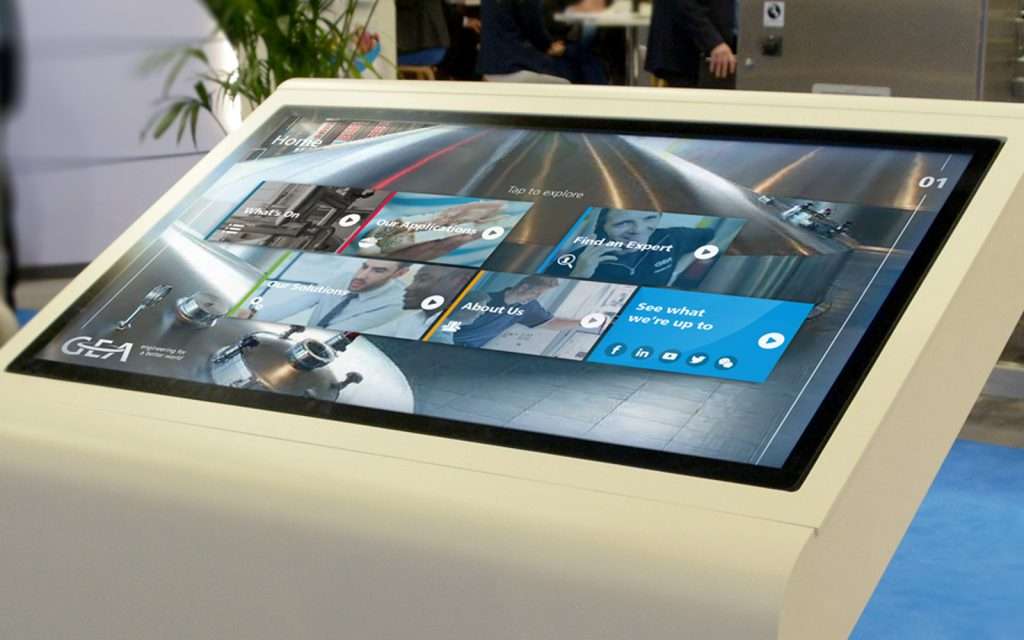
Experience for the Advanced Manufacturer GEA
2. How do you want users to feel when they use your experience?
One of the biggest mistakes you can make when creating an interactive touchscreen experience is to ignore the people who will end up using it at the end of the day. That’s right; your customers. You need to create something that will pique their interest, that they’ll (hopefully) find enjoyable or valuable in a way that they’ll remember.
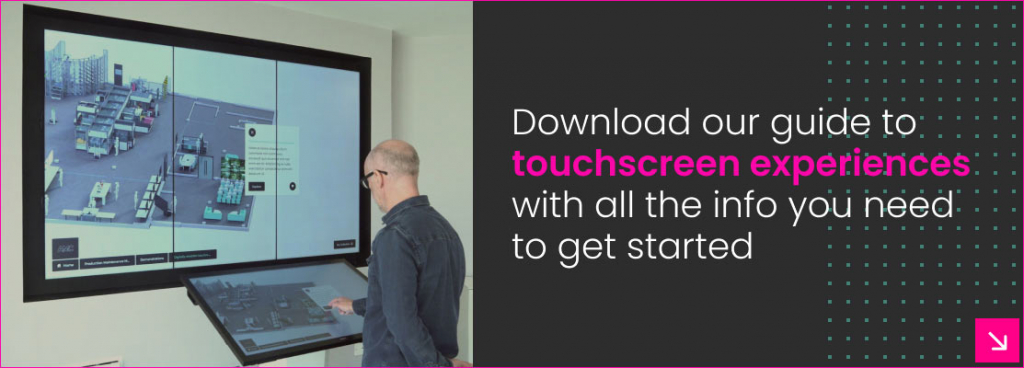
You not only need to consider the information you want them to take away from your touchscreen experience, but also the kind of overall experience you want them to have. How do you want them to feel afterwards? What’s the message you want to drive home? How do they like to interact with technology?
What kind of experience will show you in the best light and really focus on the value you bring to your customers?
TIP: You might want to design for different levels of engagement, as not everyone has the same attention span. An interactive experience lets you cater to both those that want a quick overview as well as those customers that want to deep dive into more detailed information.
3. What actions do you want them to take – and how does this align with their goals?
Closely connected to point 2, you also need to think about what you want your customers to do whilst taking part in your interactive experience, or as a direct result of it. Perhaps you’ll want them to fill in their details in order to send themselves more information (whilst observing GDPR, of course!), and therefore converting them into a lead.
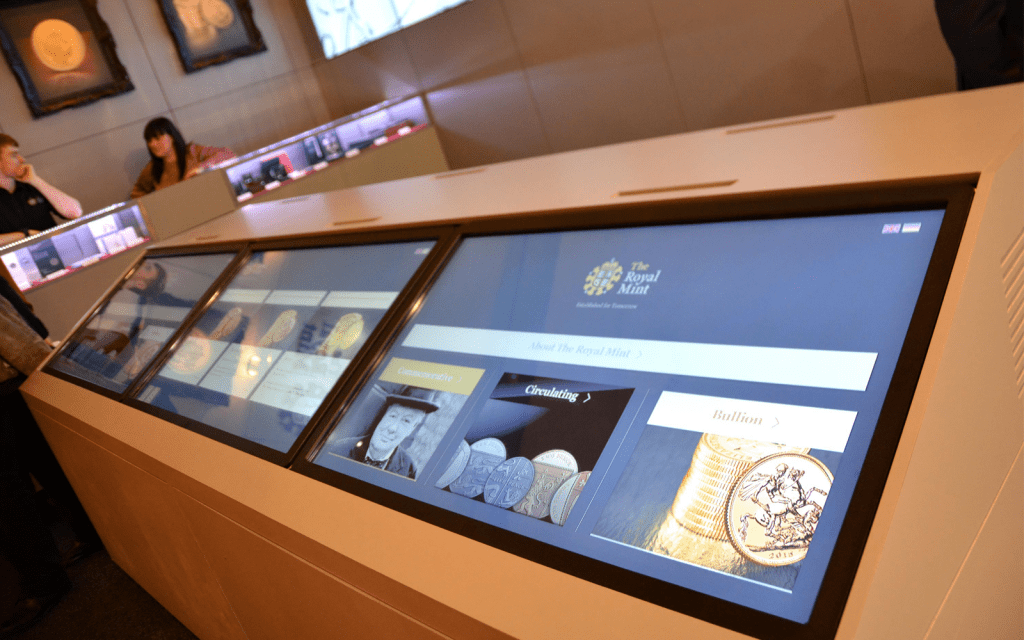
Maybe you’re looking for them to take the next step in your sales process – or deliver the message back to key decision makers who can. Whatever it is you want from users, you have to make it worth their while by giving them something they’ll want – or making it worth their while.
4. What type of hardware do you want to use?
Now you’ve hopefully got a better idea of the experience you want users to have, you can start thinking about your hardware.
This might include:
- Tables
- Kiosks
- Lectern style
- Giant iTab
- Outdoor
- Videowalls
- iPads
Too much choice? One of the best ways to decide is to carefully consider the space it’ll be going into, and what will be around it. Think about any other branding that you wish to include. Not everyone thinks of this, but it should also be fairly obvious that you want people to use your touchscreen.
The type of screen can have a big impact on how people interact, a big screen might look impressive but can be intimidating for people discouraging them from using it. Likewise, too small a screen may lack visual punch and make it hard for people to really engage in your content.
Some messaging around the screen itself might help, along with an inviting message on the touchscreen itself encouraging people to step and have a go.
5. What sort of budget do you have to work with?
Perhaps you’re going into the idea of creating an interactive touchscreen with a strict budget in mind. Or maybe you’re simply looking for a better idea of the kind of costs to expect before you commit to the idea.
There are so many factors that can affect costs, including things like the hardware you choose, the type of features you want, and the amount of content you want to include in your experience. You may also want to factor in some budget for designing the surrounding space and integrating your experience with back-end systems.
6. How will you be able to demonstrate ROI?
Of course, an interactive touchscreen should be considered an investment, and just like any investment, you’ll want to be sure you’re getting a good return. Your ROI could be purely monetary – or perhaps it’s more about gathering data and analytics for future marketing campaigns. Maybe raising awareness is a key goal.

No touchscreen experience is created equal, and everyone has different goals and agendas. We’ve put together a blog about measuring ROI and another detailing 5 of the main ways you can measure success. Including just being there and seeing the reaction from your happy customers!
7. Will you want to update your touchscreen experience?
This is another good question. If you’re intending for your interactive touchscreen experience to be used just once, at a specific event, then you may not need this feature. If, however, you’d like to update and adapt your content to suit different events, or to be updated as part of a permanent fixture in a sales suite then this is something you must let a developer know early on.
This is something that a touchscreen specialist should be happy to work with you on so that you’ll be able to update your touchscreen whenever you like from wherever you are – without outside assistance. Here’s one example of how we helped the National Library of Scotland achieve a solution they can modify and adapt whenever they need.
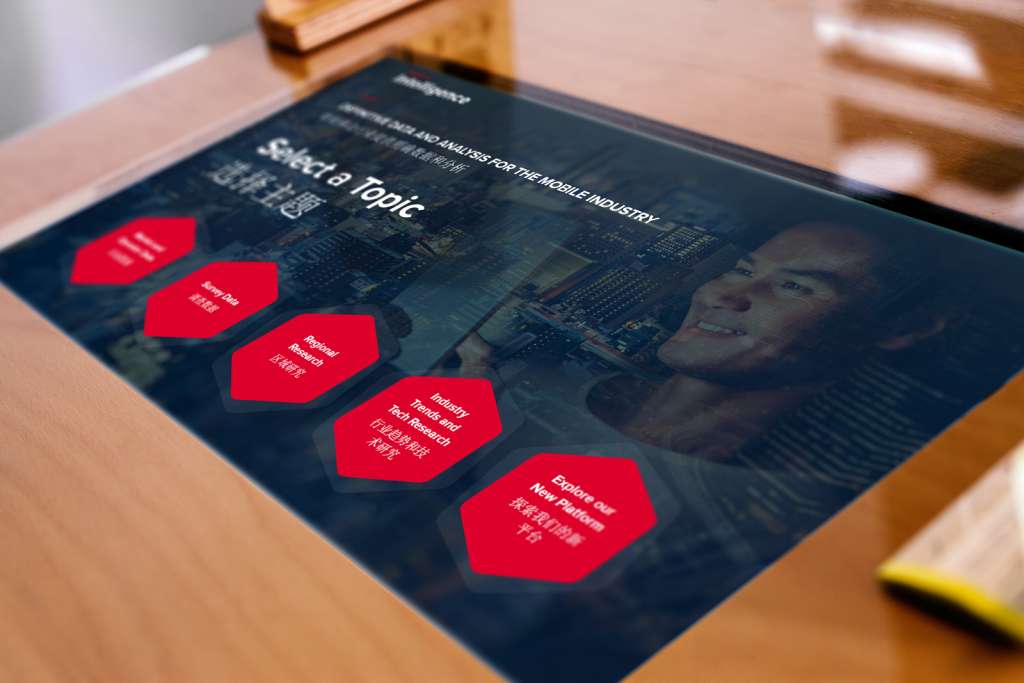
The above experience for the GSMA can be updated remotely from anywhere in the world
Advice from the touchscreen specialists
All of the above are questions an interactive touchscreen specialist will hopefully ask you about, which is why it’s important to be prepared. And, in turn, you should have some questions for them (find out what questions you should ask a touchscreen developer via our blog).
Ideally, you should be looking for someone who is ready and willing to listen to your challenges, concerns and ideas, and give you some guidance on what might be possible for your advanced manufacturing business. They should have plenty of experience developing… well… experiences! Rather than just providing the hardware.
For some peace of mind, ask if you can see some previous examples of their work – a few client testimonials wouldn’t go amiss, either.
In summary
Well, there we have it! Hopefully, we’ve managed to provide you with some food for thought when it comes to developing an interactive touchscreen experience as an advanced manufacturer. An interactive touchscreen can be a great way to help showcase your solutions and products, but if it’s your first time venturing into this area, it can seem a little overwhelming.
Start by asking yourself the questions above. And remember; we always recommend seeking out a touchscreen specialist, or agency who specialise in developing them – rather than a hardware provider – so you can create truly memorable and engaging experiences.
Want to learn more about creating a touchscreen experience your customers will love? Get in touch today on +44 (0)117 329 1712 or hello@popcomms.com. We’d love to hear from you.

Related Posts
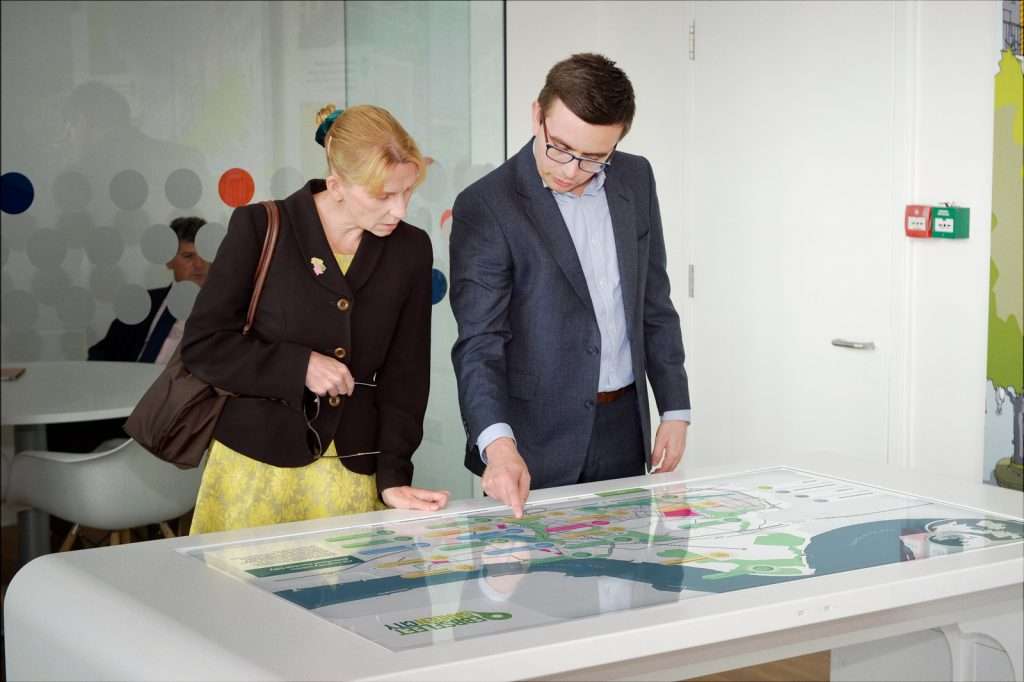
How You Can Measure the Success of an Interactive Touchscreen Experience
Read
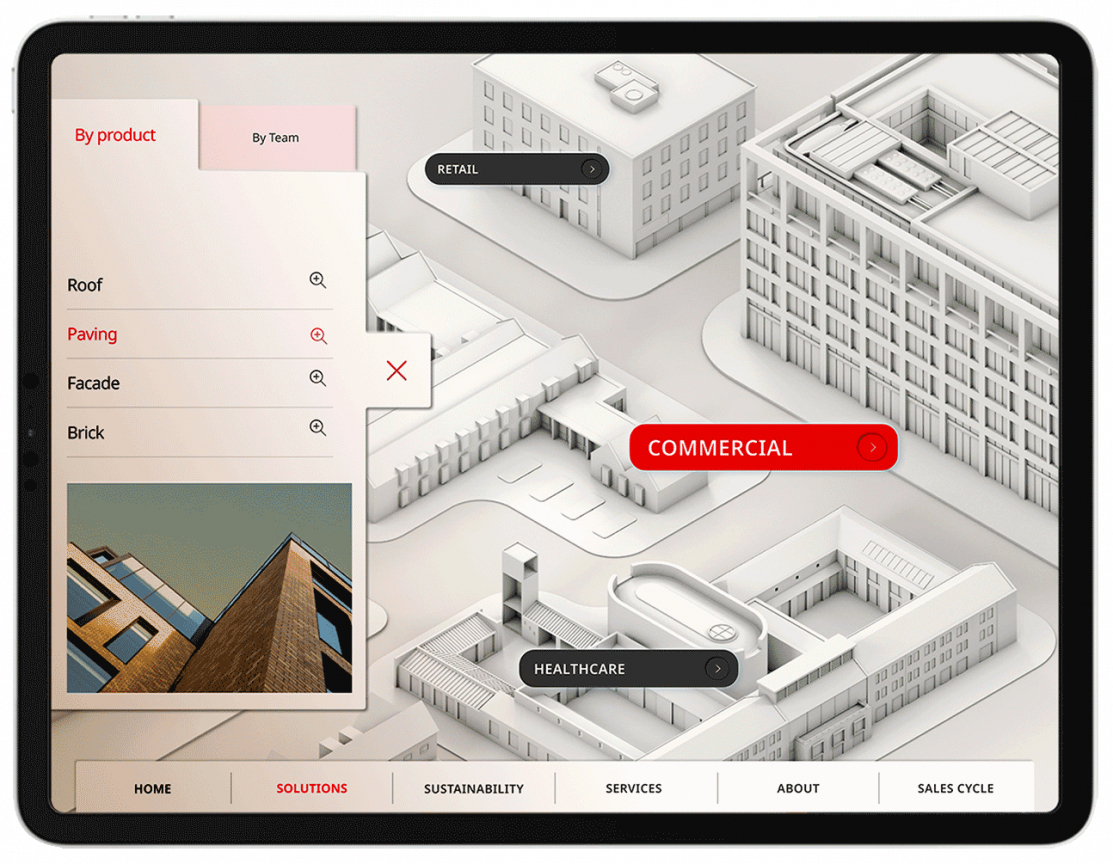
Why Conversational Presenting & Interactive Touchscreens Go Hand-in-Hand
Read
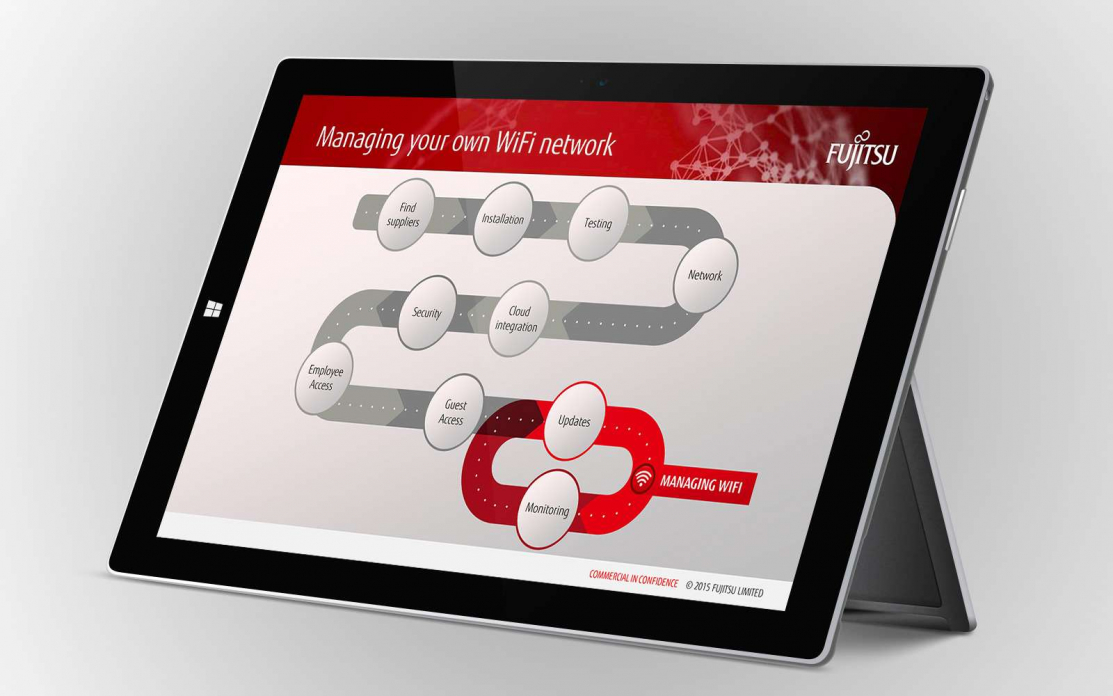
Guide to Micro-Interactions for Interactive Touchscreen Experiences
Read
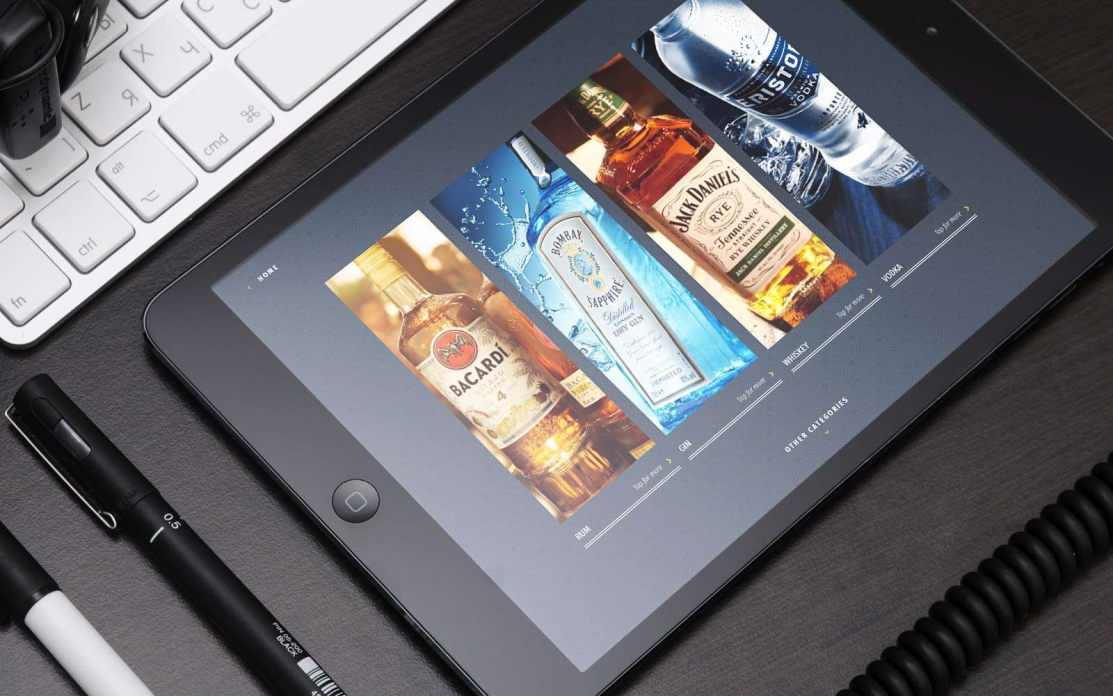
Why You Need A Bespoke Interactive Sales Enablement Tool for the Best Customer Experience
Read